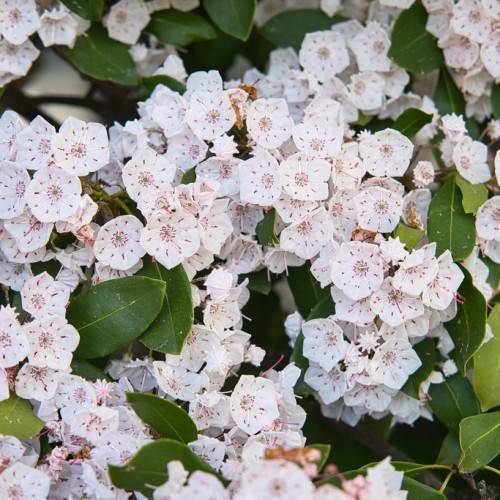
mountain laurel
Kalmia latifolia 'Raspberry Glow'
Cycle:
Perennial
Watering:
Average
Hardiness Zone:
4 - 9
Flowers:
Flowers
Sun:
Part shade
Leaf:
Yes
Growth Rate:
Low
Maintenance:
Moderate
Poisonous To Humans:
Yes
Poisonous To Pets:
Yes
Drought Tolerant:
Yes
Care Level:
Medium
watering
Mountain laurel (Kalmia latifolia 'Raspberry Glow') requires regular watering to keep the soil moist, but not drenched. During the spring and summer months when the plant is actively growing and flowering, you should water it every 7-10 days. During the autumn and winter months when the plant is dormant, you should water it every 14-21 days. Water the Mountain laurel at the root zone near the base of the plant, allowing the water to soak in gradually and not run off of the plant. Avoid overhead watering or saturating the leaves, as it may cause fungal diseases if the leaves stay wet for too long.
sunlight
Mountain laurel (Kalmia latifolia 'Raspberry Glow') thrives in sunny locations with morning sunlight and afternoon shade. The ideal exposure will give this plant a full day of bright direct sunlight for about 4-6 hours coupled with plenty of shade in the afternoon. During the summer months, when the sun is strongest, try to provide some afternoon shade, such as from a tree, or use light-colored shades to help filter the sun's rays. During the winter months, when the sun is less intense, the plant's exposure to direct sunlight can be increased a bit. Also, the removal of any snow or ice will help ensure the plant is getting the right amount of sunlight. For optimal growth, mountain laurel should receive 4-6 hours of direct sunlight per day in spring and fall, and at least 6-8 hours of direct sunlight in summer.
pruning
For best results, Mountain Laurel (Kalmia latifolia 'Raspberry Glow') should be pruned during the late winter season when it is dormant. Typically, pruning is necessary to maintain a desired size and shape, as well as to remove dead, diseased, or broken branches. It is best to prune no more than 30% of the total plant each year. Any branches that are pruned should be cut just above a bud and at a 45 degree angle.
